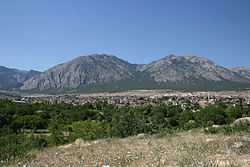Kargı
From Wikipedia, the free encyclopedia
| Kargı | |
|---|---|
 | |
 Kargı | |
| Coordinates: 41°08′04″N 34°29′14″E / 41.13444°N 34.48722°ECoordinates: 41°08′04″N 34°29′14″E / 41.13444°N 34.48722°E | |
| Country | Turkey |
| Province | Çorum |
| Government | |
| • Mayor | Ahmet Hamdi Akpınar (AKP) |
| • Kaymakam | Tolga Kamil Ersöz |
| Area[1] | |
| • District | 1,394.19 km2 (538.30 sq mi) |
| Elevation | 400 m (1,300 ft) |
| Population (2012)[2] | |
| • Urban | 5,327 |
| • District | 15,780 |
| • District Density | 11/km2 (29/sq mi) |
| Post code | 19910 |
| Website | www.kargi.bel.tr |
Kargı is a district of Çorum Province in the Black Sea region of Turkey. It is located at 106 km from the city of Çorum.
Name
The first settlement in Kargı is known in the Hellenistic period as Bleane, mentioned by Strabo.[3]
Economy
The district is known for growing high-quality rice and okra and for producing a particular type of crumbly goat's milk cheese called tulum peyniri.
References
- ↑ "Area of regions (including lakes), km²". Regional Statistics Database. Turkish Statistical Institute. 2002. Retrieved 2013-03-05.
- ↑ "Population of province/district centers and towns/villages by districts - 2012". Address Based Population Registration System (ABPRS) Database. Turkish Statistical Institute. Retrieved 2013-02-27.
- ↑ “There remains that part of the Pontic province which lies outside the Halys River, I mean the country round Mt. Olgassys, contiguous to Sinope. Mt. Olgassys is extremely high and hard to travel. And temples that have been established everywhere on this mountain are held by the Paphlagonians. And round it lies fairly good territory, both Blaene and Domanitis, through which latter flows the Amnias River. Here Mithridates Eupator utterly wiped out the forces of Nicomedes the Bithynian — not in person, however, since it happened that he was not even present, but through his generals.” From Strabo’s Geography 12.3.40{http://www.archive.org/stream/geographyofstrab05strauoft/geographyofstrab05strauoft_djvu.txt} (*Sinopis in the source was corrected to Sinope and *Faphlagonians [sic] to Paphlagonians)
| ||||||||||||||||||||||||||||||||||||||||||||||||||||||
This article is issued from Wikipedia. The text is available under the Creative Commons Attribution/Share Alike; additional terms may apply for the media files.
